
Overview
High pressure systems look like bland and boring blobs on the weather map, but they can also harbor potentially
tragic weather conditions, particularly to aviation. Here we examine a sultry, murky high pressure in mid-July of 1999 when an aviation accident claimed the life of one of the most recognized faces in America: John F. Kennedy, Jr.
Case study
July 16, 1999 is a hot, hectic Friday in New York City. Manhattanites rush to escape the city’s heat and spend the weekend on the coast or in the mountains. Included in this crowd are John Fitzgerald Kennedy, Jr., his wife Carolyn Bessette Kennedy, and her sister Lauren Bessette. He is “JFK Jr.,” the son and namesake of the 35th President
of the United States. On July 16 they are traveling to a family wedding in Hyannis Port, Massachusetts. But first they will stop to drop off Lauren at Martha’s Vineyard, a resort island frequented by the Kennedys south of the Massachusetts coast (see the map).
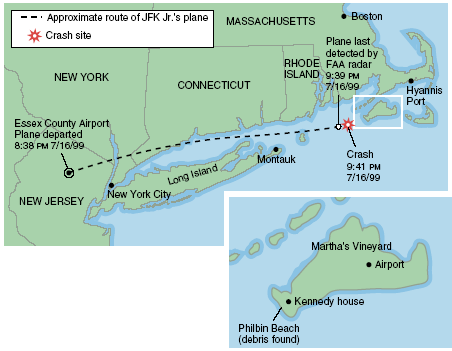
They will fly to their destinations. JFK Jr. is qualified to fly under “visual flight rules”— when the sky is clear enough to see where you’re going. He doesn’t yet qualify to use a plane’s instrument panel to navigate when
visibility is low, however. One normally would think that this shouldn’t be a problem on July 16th; there is a
high-pressure system sprawling over the eastern United States and the weather reports and forecasts indicate calm and mostly clear skies (See surface map below).
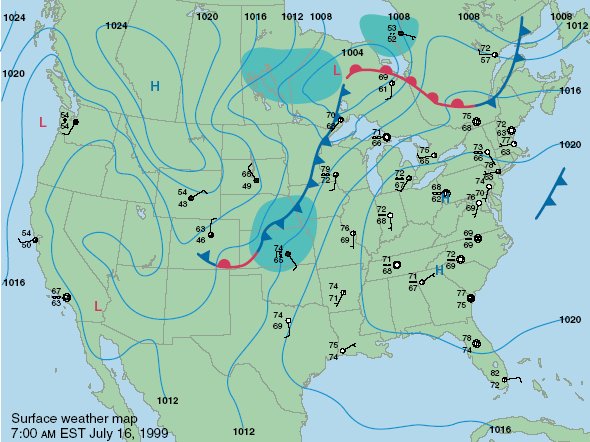
The light winds associated with the ridge parked above the high (see 500 mb map below) mean that the surface anticyclone will be stationary for the foreseeable future.
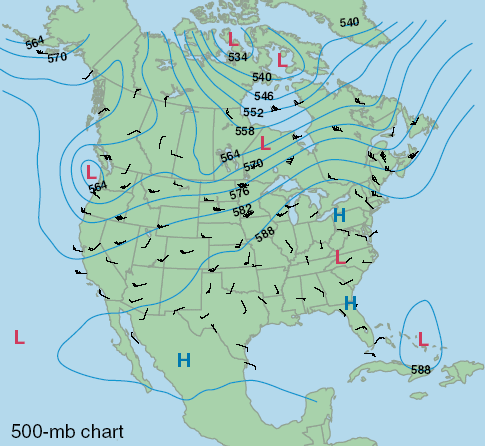
Stuck in weekend traffic, the Kennedys don’t reach the Essex County Airport in
New Jersey until after 8:00 PM. JFK Jr. prepares his six-seat Piper Saratoga singleengine
plane for flight, and the trio takes off at 8:38 PM Eastern time, twelve minutes
after sunset. The trip to Martha’s Vineyard, less than 320 kilometers (200
miles), should take a little over an hour; the Piper Saratoga’s top speed is 307 km/hr
(191 mph). The flight continues uneventfully over Long Island Sound until around the
1-hour mark. Fifty-five kilometers (34 miles) from the Martha’s Vineyard airport,
Kennedy begins a slow descent from a cruising altitude of 1.7 kilometers (5600
feet). Five minutes later, at 700 meters (2300 feet), the Piper Saratoga turns to
the right and climbs to 790 meters (2600 feet). One minute afterward, the plane
descends and turns back to the left. Only thirty seconds later, the plane turns
to the right and dives, spiraling downward at the astonishing rate of 1430 meters
(4700 feet) per minute. At 9:41 PM the Piper Saratoga smashes into the Atlantic
Ocean just 12 kilometers (7.5 miles) from the southwestern shore of
Martha’s Vineyard, killing the Kennedys and Bessette instantly.
What happened?
Investigators quickly ruled out a problem with Kennedy’s plane.
Instead, pilots and meteorologists alike pointed to the surprisingly low visibility in
the “clear” anticyclone over the Northeast that weekend.
The cloudless weather in anticyclones is usually welcome. However, the sinking
air and lack of strong winds in a high traps air in the lower troposphere. This air then
takes on the characteristics of the region it sits over—the process of “air mass modification”
we talked about in the previous chapter. If a high remains over a heavily
populated region for more than a couple of days, it can trap and concentrate pollutants
from cars and industry.
July 16 was one of the most polluted days of 1999 in the northeastern United
States. A week’s worth of pollution from the Midwest and the East Coast found its
way into the high’s circulation. The pollution then traveled on the high’s anticyclonic
winds and collected over New England and its coastline.
Pollution affects aviators because polluted air is much harder to see through
than unpolluted air, even in a cloudless sky. Satellite pictures and
photographs (see below) from July 16 show that the polluted air was much less
transparent than cleaner air at other times and places. Other analyses indicate that
the temperature inversion caused by the sinking motion in the anticyclone created
a layer of extremely polluted air about 1 kilometer (3000 feet) above the ground
over the Northeast.
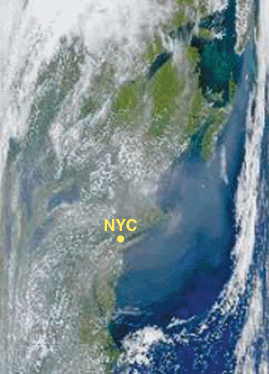
Above: A high-resolution visible satellite picture of the
eastern United States is shown for July 16, 1999 at 5:20 PM
(EST). The milky, gray region along the coast east and northeast of New York City (NYC) is polluted air.
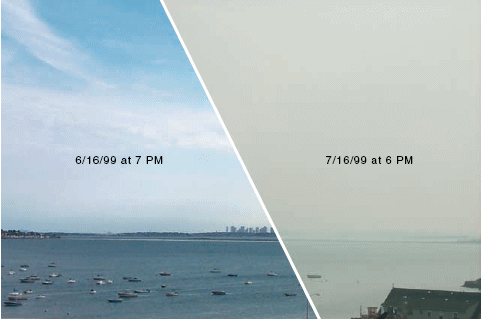
Above: Photographs of the skyline of Boston, Massachusetts, one
month apart, on the evenings of June 16 and July 16, 1999. Notice the poor visibility on
July 16, just hours before John F. Kennedy, Jr.’s plane departed for the coastline of southern
Massachusetts.
How does this explain JFK Jr.’s plane crash?
While the plane was cruising at 1.7 kilometers (5600 feet) over Long Island Sound, the flight
proceeded normally because the pollutants were trapped below this altitude by the
anticyclone. Trouble ensued when the plane descended into the murkiest layer of
the pollution, at or a little below 1 kilometer (3000 feet). Visibility would have
decreased immediately and drastically. Furthermore, the plane was over water, at
night. Any lights or landmarks would have been blotted out by the haze.
At this point an experienced pilot would have navigated the plane using the instrument
panel on the aircraft. Kennedy was not yet qualified to do this. Instead, he
first tried to steer and climb out of the low-visibility pollution layer—the turn to the
right and the ascent to 790 meters (2600 feet). This strategy didn’t improve visibility.
Nearing land but unable to see any lights due to the pollution, Kennedy turned
back to his original course. Then he became disoriented and inadvertently guided
his plane into a fatal dive, not an uncommon reaction to VFR pilots flying in IFR conditions.
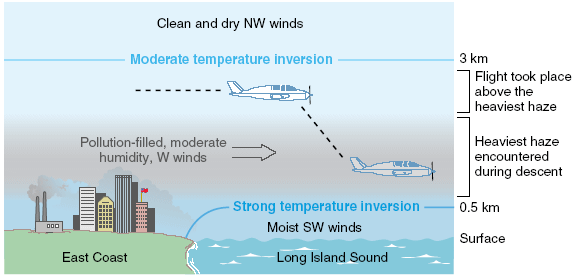
Above: A schematic explaining how the polluted anticyclone contributed
to the crash of John F. Kennedy, Jr.’s airplane. Temperature inversions within the anticyclone
trapped and concentrated the pollutants in a narrow layer corresponding to
the altitude at which Kennedy’s plane went out of control, probably because of pilot disorientation.